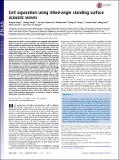Cell separation using tilted-angle standing surface acoustic waves
Author(s)
Peng, Zhangli; Dao, Ming; Geri, Michela; Ding, Xiaoyun; Lin, Sz-Chin Steven; Li, Sixing; Li, Peng; Chen, Yuchao; Suresh, Subra; Huang, Tony Jun; ... Show more Show less
DownloadDing-2014-Cell separation usin.pdf (1.092Mb)
PUBLISHER_POLICY
Publisher Policy
Article is made available in accordance with the publisher's policy and may be subject to US copyright law. Please refer to the publisher's site for terms of use.
Terms of use
Metadata
Show full item recordAbstract
Separation of cells is a critical process for studying cell properties, disease diagnostics, and therapeutics. Cell sorting by acoustic waves offers a means to separate cells on the basis of their size and physical properties in a label-free, contactless, and biocompatible manner. The separation sensitivity and efficiency of currently available acoustic-based approaches, however, are limited, thereby restricting their widespread application in research and health diagnostics. In this work, we introduce a unique configuration of tilted-angle standing surface acoustic waves (taSSAW), which are oriented at an optimally designed inclination to the flow direction in the microfluidic channel. We demonstrate that this design significantly improves the efficiency and sensitivity of acoustic separation techniques. To optimize our device design, we carried out systematic simulations of cell trajectories, matching closely with experimental results. Using numerically optimized design of taSSAW, we successfully separated 2- and 10-µm-diameter polystyrene beads with a separation efficiency of ~99%, and separated 7.3- and 9.9-µm-polystyrene beads with an efficiency of ~97%. We illustrate that taSSAW is capable of effectively separating particles–cells of approximately the same size and density but different compressibility. Finally, we demonstrate the effectiveness of the present technique for biological–biomedical applications by sorting MCF-7 human breast cancer cells from nonmalignant leukocytes, while preserving the integrity of the separated cells. The method introduced here thus offers a unique route for separating circulating tumor cells, and for label-free cell separation with potential applications in biological research, disease diagnostics, and clinical practice.
Date issued
2014-08Department
Massachusetts Institute of Technology. Department of Materials Science and Engineering; Massachusetts Institute of Technology. Department of Mechanical EngineeringJournal
Proceedings of the National Academy of Sciences of the United States of America
Publisher
National Academy of Sciences (U.S.)
Citation
Ding, X., Z. Peng, S.-C. S. Lin, M. Geri, S. Li, P. Li, Y. Chen, M. Dao, S. Suresh, and T. J. Huang. “Cell Separation Using Tilted-Angle Standing Surface Acoustic Waves.” Proceedings of the National Academy of Sciences 111, no. 36 (August 25, 2014): 12992–12997.
Version: Final published version
ISSN
0027-8424
1091-6490